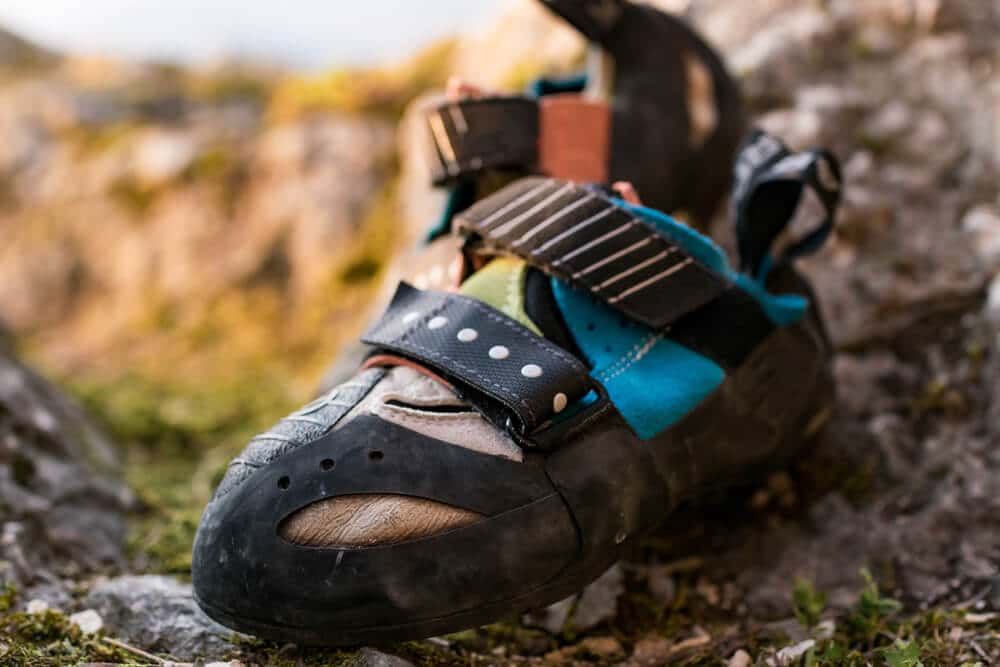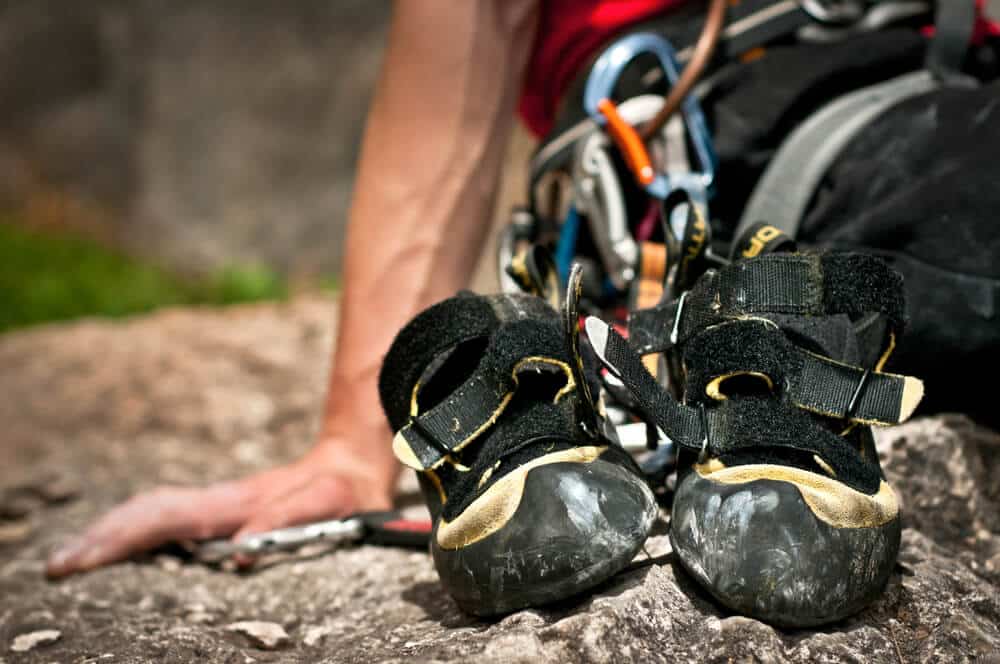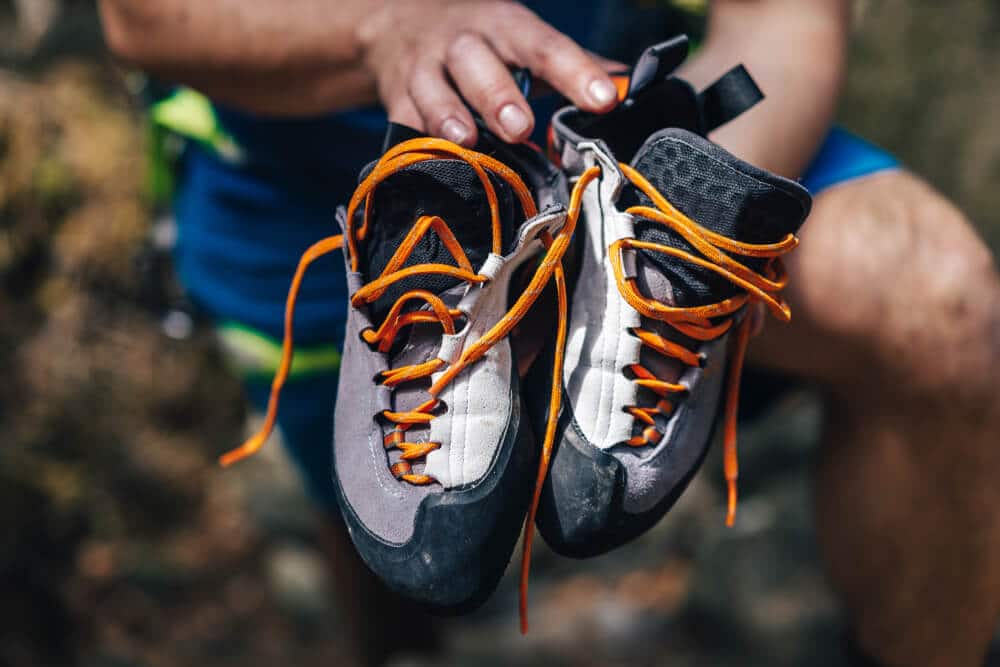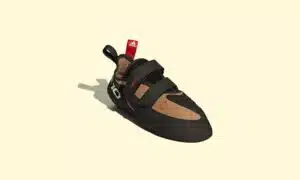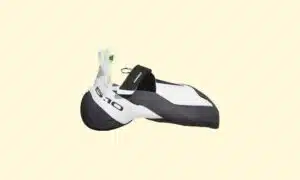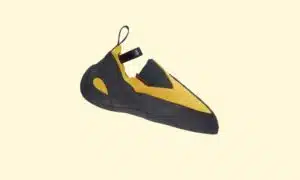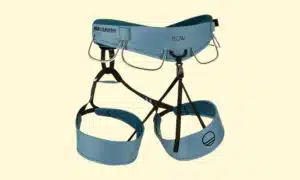All climbers know that sneakers aren’t going to work for sending. The majority of us (besides a rare few barefoot climbers) opt for climbing shoes, so that the sticky rubber can help keep our feet on the rock.
However, what you might not know is that there are many different types of climbing rubber, and what type is used on your pair of shoes can affect how you stick to various footholds.
What is Climbing Shoe Rubber?
Rubber compounds are used in many products, including tires, clothes, and furniture. Natural rubber is made of latex, which is produced by rubber trees. Natural rubber is still used in some applications, but most rubber used in commercial products now is synthetic. Synthetic rubber is more consistent in different temperatures, and is made primarily from fossil fuels with various other additives that affect the texture.
Most products use a generic, mass-produced rubber. The rubber for a pair of climbing shoes is a little different: most companies use special formulas that are specifically designed to perform well on rock and plastic holds. Climbing shoe manufacturers want to create rubber that takes the shape of any tiny bumps or rock textures they are placed on. This maximizes the surface area of rubber that is in contact with the foothold, thus giving you the best possible grip.
Different Types of Rubber and Their Uses
There are many different formulas of climbing shoe rubber, and they have different benefits and drawbacks. Knowing these can help you make an informed decision when purchasing a new pair.
Soft Rubber
Softer rubber compounds provide a higher level of sensitivity and will allow you to better feel the footholds you are stepping on. This can allow you to feel more confident when performing delicate or balancey moves.
Many people prefer a softer rubber for slab climbing, and it can help you maximize surface area when smearing. Soft rubber tends to have less durability.
Stiff Rubber
While soft rubber can be beneficial for certain types of climbing, maximizing surface area can be detrimental for certain styles.
Specifically, if you need to stand on small edges or on a little crystal of rock, a stiffer shoe will give you more stability and confidence. This will decrease sensitivity, but the tradeoff is good edging performance on small footholds and better durability.
Rubber Comparison
Now that we’ve established some background on climbing shoe rubber, let’s dive into some specific types of rubber so you can make an informed decision about which type of shoe to use for which application.
There are a few major manufacturers of climbing shoe rubber, and each company has various formulas for different applications. The specific formulas are kept within the companies, but they all include fillers such as carbon and clay in addition to the fossil-fuel based synthetic rubber.
Vibram Rubber
Vibram is one of the major manufacturers for climbing shoe rubber. The company has been around since 1937, and making high-quality rubber is their priority. They do not make climbing shoes themselves; they solely manufacture rubber.
Various companies use Vibram’s rubber, including La Sportiva, Scarpa, and Tenaya. Not every shoe from each of these brands is made with Vibram rubber– it tends to be used in more expensive shoes. Vibram currently makes three main types of rubber:
- Vibram XS Edge: As the name suggests, this might be the best rubber for standing on small edges and tiny holds. Vibram recommends the product for big wall and multi pitch climbing.
- Where it’s used: It’s used in many high performance models, including the La Sportiva Miura and Katana Lace (men’s versions) and the popular trad climbing shoe, the TC Pro. It’s also used by Scarpa in shoes like the Vapor V (men’s version).
- Vibram XS Grip: The Vibram XS Grip is another popular rubber compound. It’s not as stiff as the XS Edge, but it’s not super soft either.
- Where it’s used: The XS Grip compound is widely used by many slightly less well-known shoe manufacturers, such as Ocun, Tenaya, and Red Chili.
- Vibram XS Grip 2: This XS Grip 2 is perhaps the most high-end rubber on the market. It’s softer than both the XS Edge and the XS Grip, and is well suited for bouldering and hard sport climbing. The rubber allows the climber to both smear and edge well, which is an important balance for many climbs. It’s well suited to overhanging terrain.
- Where it’s used: This compound is only used by La Sportiva and Scarpa (other companies don’t have access to the compound). Models using the XS Grip 2 include the Scarpa Instinct, the La Sportiva Miura VS(women’s), and both the Solution and the Solution Comp.
Frixion Rubber
Although La Sportiva uses Vibram’s rubber for many of their more expensive shoes, they also have their own rubber line which they utilize in more affordable models. They have two major types of climbing shoe rubber that they manufacture; they also make rubber for their approach shoes and other products.
- Frixion Black: This is a relatively stiff rubber compound that is designed for performance. It’s not the most durable of compounds, but it won’t wear out too fast.
- Where it’s used: Used in La Sportiva shoes such as the Tarantulace and the Oxygym.
- Frixion Eco: The Eco is pretty similar to the Black, but it’s a more eco-friendly compound. La Sportiva has made sustainability a priority in many aspects of their company, and this rubber compound is made from production scraps and recycled materials.
- Where it’s used: La Sportiva has several models of eco-friendly shoes where the Frixion Eco rubber is used, such as the Cobra Eco and Mythos Eco.
Stealth Rubber
Another major brand of climbing shoe rubber on the market is Stealth rubber, which is made by Five Ten, a popular climbing shoe manufacturer.
It’s a high-quality, high friction rubber that has been endorsed by many popular climbing brands. Five Ten also uses their stealth rubber on their approach and biking shoes. The two main types of Stealth rubber are:
- Stealth C4: The Stealth C4 is a soft and sticky rubber that does well on slabs and smears, as well as on overhung terrain. It’s decent at edging at first, but this ability fades over time. The compound is similar to the XS Grip 2, but doesn’t last quite as long.
- Where it’s used: Five Ten uses this rubber in many of their popular shoes, such as the previous Anasazi, Moccasym and the revamped NIAD line.
- Stealth Hf: The Hf rubber is softer than the C4, so it doesn’t last very long. It’s built for performance, not durability, and does well on steep terrain.
- Where it’s used: Stealth Hf is used in performance oriented Five Ten shoes, such as the Team and Dragon.
Trax Rubber
Another major rubber manufacturer is Evolv– they company makes Trax rubber. There’s three main types of Trax rubber, all of which have different specialties:
- Trax Sas: This is Evolv’s most popular rubber, and it works well for a variety of situations. In terms of stiffness, it’s a medium stiffness rubber, neither super soft nor super stiff. This means it does well both indoors and outdoors and on lots of types of terrain, though it won’t totally excel anywhere.
- Where it’s used: Most of Evolv’s shoes come with this rubber.
- Trax Xe: This compound is somewhat similar to the XS Edge– it it quite stiff and durable, and does well on tiny edges and crystals. It’s best suited for technical outdoor climbing, but can work for newer climbers in the gym too.
- Where it’s used: This rubber is found on the Evolv General, a shoe designed for outdoor sport and trad climbing.
- Trax Gt: This rubber was specifically designed for climbing gyms, as it’s formulated nor to leave marking behind, which helps the holds stay clean. It’s soft, but it’s also designed to last relatively long.
- Where it’s used: This is Evolv’s newest rubber, so they haven’t yet started manufacturing shoes with it.
How To Select the Best Rubber for You
It can be difficult to know which rubber will work best for you. The major consideration is the style of climbing you focus on.
- Steep sport climbing or bouldering: For overhung climbing performance, a downturned and relatively soft shoe is best. Thus, you’ll want a soft rubber: the Vibram XS Grip 2 is a good option, as is either of the Stealth rubbers.
- Technical face climbing: For technical face climbing, you’ll want rubber that provides top edging performance. Extremely soft shoes won’t work here; you’ll want a stiff rubber for pushing hard on small footholds. The Vibram XS Edge is a great choice, as Trax Evolv Xe.
- Trad climbing: The rubber you’ll want for trad climbing tends to be pretty similar to what you’d use for face climbing. Trad climbing often requires edging in addition to jamming, so the XS Edge and the Trax Xe are good choices for both confident edging and comfortable foot jamming.
- Indoor climbing: If you mainly climb indoors, you probably encounter a lot of volumes and slopers. Microscopic footholds and tiny edges are less common indoors. So, you’ll want to go with the softest shoes you can– choose a softer rubber that can smear and performs well on plastic.
- I like it all!: If you do a lot of different kinds of climbing, it’s best to go with a medium stiffness rubber that can perform well on a variety of terrain. The Trax Sas ia great option here, and the Frixion options can work well too, especially if you are looking for a more affordable shoe.
Other Factors
Besides the type of climbing you like to do, there are some other factors to consider too.
- Skill level: One of these is your climbing level. Not all rubbers on the market cost the same– higher end rubbers come on more expensive shoes.
- If you’re a newer climber, you might not need to invest in a pair of these expensive shoes. When you’re climbing at a lower level, the type of rubber tends not to matter quite as much. You could go with something such as the Frixion Black, which is relatively adaptable and comes on affordable shoes such as the Tarantulace. For advanced climbers, rubber type might matter a bit more.
- Size: Another factor to consider is your size: heavier climbers tend to do better with a stiffer rubber, as they have more weight to push into the rubber. Lighter climbers often like softer rubbers. This is why women’s shoes are sometimes made with softer rubbers than men’s shoes.
- Durability: Stiffer shoes tend to be more durable, while softer, more sensitive shoes tend to wear out faster. So durability is another factor to consider: if you want your shoes to last a while, consider stiffer rubbers.
Resoling
Many rock climbers choose to get their shoes resoled when the rubber wears out. This can be an opportunity to try a new rubber, as you don’t necessarily have to get shoes resoled with the same compound they came with.
When you choose a resole company, you can see what different rubber compounds they have available. Most companies have a selection of the most popular compounds.
However, it’s important to remember that it’s not only the rubber on the sole that affects the stiffness or softness of a climbing shoe and how it performs on different terrain. The outsole of the climbing shoe refers to the rubber that’s actually in contact with the rock, but climbing shoes also have an upper (the part that wraps around the top of your foot) and a midsole (the rubber beneath the arch of your foot).
Even if you get the outsole of your shoe resoled, the midsole and upper will still affect the shoe’s performance. For example, if you get a very stiff shoe resoled with softer rubber, it won’t perform the same as a shoe that is entirely designed to be soft and sensitive.
Last Things To Consider
If you stand on lots of tiny edges, a stiffer compound is your best bet.
If you climb inside or need to smear on polished rock, softer compounds will provide the best friction.
Whatever choice you make for your next pair of shoes, it’s important to make an informed decision. Having the stickiest rubber possible can help you send!



